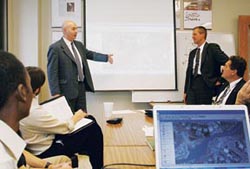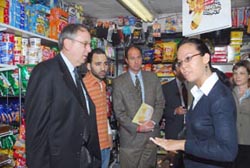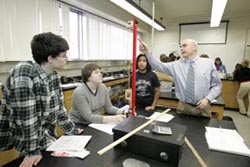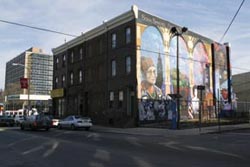“Great Universities, Great Cities”
| 215-204-4667 | |
| On Friday, March 23, the day following the investiture of President Ann Weaver Hart, Temple will hold a conference titled “Great Universities, Great Cities” as part of President Hart’s inauguration. The conference will explore the intersection of universities’ research, teaching and service with the communities in which those institutions are located, and it will feature leaders from the campus, the city and the region. Morning sessions, grouped into four concurrent “strands,” will explore neighborhood renewal and building community; public-health issues, such as obesity and violence; advancing literacy; and using arts and culture to encourage connections among students, scholars and the community. Marc Morial, president and CEO of the National Urban League, will deliver an invitation-only luncheon address.The afternoon will feature work by engineering, architecture and communications students; an online media literacy program for adolescent girls created by Temple Professor Renee Hobbs; a trolley tour of Philadelphia murals and community gardens; a talk by Temple Professor Bryant Simon on the cultural impact of Starbucks; conversation and poetry with Professor Rachel Blau DuPlessis; and a book signing and reading by Tommie Smith from his autobiography, Silent Gesture. Smith, along with John Carlos, is remembered for raising his right hand in the name of human rights on the medal stand at the 1968 Olympic Games. The conference planning committee was co-chaired by Elizabeth Leebron Tutelman, professor of broadcasting, telecommunications and mass media, and Jodi Levine Laufgraben, associate vice provost and director of periodic program review. A full program of events is available at www.temple.edu/inauguration.
Below are the topics of concurrent morning sessions, which will be held from 9 to 11:45 a.m. Each topic summary includes examples of ways in which Temple is providing research and service in these areas (not all examples will be part of Friday's presentations). |
|
|
'Preserving Place' Temple faculty members, in partnership with community members, are working to preserve both the physical environments and social fabric of communities. For example, Temple’s Urban Workshop, part of the Architecture Department, connects architecture, art, geography and urban studies, and landscape architecture students with community development organizations to redesign the physical environment of neighborhoods, such as the Norris Square Neighborhood and the Village of Arts and Humanities in North Philadelphia.
|
 Photo by Ryan S. Brandenberg/Temple University
Department of Engineering | FEMA Michel Boufadel (left), chair of civil and environmental engineering, discusses floodplain maps of the Pennypack Creek Watershed with officials from the Federal Emergency Management Agency during a November 2006 meeting at the College of Engineering. Center for Sustainable Communities director Jeff Featherstone stands at right.
|
|
And the Center for Intergenerational Learning’s “Communities for All Ages” — a program that recently earned center Director Nancy Henkin an Ashoka Fellowship — uses a lifespan approach to community planning. In projects supported by the Ford Foundation and National Science Foundation, anthropology faculty member Judith Goode and her students have looked beyond the physical environment to explore and examine the social environment of some of Philadelphia low-income neighborhoods. They discovered that Philadelphia’s agenda for improving its appearance and image has often worked to destabilize and divide these low-income neighborhoods. The Temple group has used its findings to offer possible strategies for achieving ways to balance the choice between the often-competing visions of residents, city officials and planning experts for those neighborhoods. Temple’s work with communities to sustain and renew their neighborhoods reaches out to the suburbs, as well. The Ambler College’s Center for Sustainable Communities garnered local and national attention for its four-year watershed study when Federal Emergency Management Agency officials replaced their floodplain maps with those Temple faculty and graduate students had developed, saying “their accuracy and detail could become the model for assessing flood risk in high-growth areas nationwide,” according to a Jan. 7, 2007, article in The Philadelphia Inquirer. |
|
 Photo by Kelly & Massa
Foster Rich McKeown (left), chief of staff to U.S. Secretary of Health and Human Services Mike Leavitt, and Gary D. Foster (center), professor of Medicine and Public Health and director of Temple's Center for Obesity Research and Education (CORE), listen as Lisandra Lamboy, project manager of The Food Trust, describes "Snack Smart" during a visit to a corner grocery store and an elementary school in Philadelphia's Juniata neighborhood in October 2006. Foster and CORE have collaborated with The Food Trust since 2001 on implementing and evaluating community-based obesity prevention programs like "Snack Smart.
|
‘Creating Healthy and Safe Communities’ Gittis Student Center, room 200C University–community partnerships are essential to creating healthy and safe communities. Temple takes a proactive role in many aspects of public wellness, notably, in obesity and violence — top public-health concerns in Philadelphia and the nation. The School of Medicine's Center for Obesity Research and Education confronts the problem of obesity with more than research — it leads the way in finding solutions to the nation's obesity epidemic through prevention and treatment. These efforts range from educational outreach programs in Philadelphia communities and schools to encourage healthier choices to helping individuals overcome barriers to a healthier lifestyle through counseling, education and time-management techniques. |
|
Among Temple’s recent safety and anti-violence efforts is its involvement in the Philadelphia Collaborative Violence Prevention Center, which works directly with community groups to study and learn what can be done to prevent violence among youth, specifically children ages 10–14, in an effort to intervene before trouble starts. Four cores form the PCVPC: administration, information, communication and dissemination, and research, for which Alice Hausman, professor and chair of public health, serves as co-director. Hausman is also director of Temple's multidisciplinary Center for Preparedness, Research, Education and Practice, which partners with state and local government agencies and emergency response organizations to study and improve Pennsylvania’s emergency preparedness in natural and perpetrated disasters. On the national level, the Department of Criminal Justice is involved in a National Institute of Justice study examining what individual, program and neighborhood factors effect juvenile recidivism — the rate at which young people commit crimes after being released from court-ordered programs. The Temple research, focusing on juvenile delinquents in Philadelphia, may shed light on the need for these programs — which currently focus almost exclusively on individual and family issues — to address how neighborhood characteristics influence at-risk youths. |
|
|
‘Advancing Literacy’
Temple faculty members from a range of disciplines, from education to mathematics to psychology, are exploring emerging conceptions of literacy, and their work is addressing how educators can help meet these changing needs and new expectations in educating today’s youth.
|
 Photo by Joseph V. Labolito/Temple University
Associate professor of physics Zbigniew Dziembowski demonstrates for juniors from Philadelphia’s Masterman High School how to set up a block-and-tackle machine, among a range of equipment purchased through grants from the National Science Foundation and the U.S. Department of Education that were intended to help prepare middle- and high-school teachers in the instruction of physics.
|
|
In the College of Education, faculty members are exploring social and economic impacts on learning, such as Assistant Professor Wanda Brooks' research with middle-grade African-American students across suburban and urban contexts, which has revealed the sophisticated ways in which these youth rely on their cultural knowledge and experiences when selecting and interpreting literary texts. And in studies with young men from various backgrounds, Professor Michael Smith has shown that literacy activities that are characterized by a sense of competence and control, an appropriate challenge, clear goals, a focus on the immediate, and a social dimension foster engagement in literacy out of school, but are too often lacking in school. Researchers at Temple’s Infant Laboratory, part of the Psychology Department and located at the Ambler Campus, have conducted research on young children’s spatial development, memory, language development and reading and the role of play in learning. The lab is co-directed by Nora Newcombe, who recently was awarded a multimillion-dollar grant by the National Science Foundation to explore spatial learning and its necessary role in educational practice, and Kathy Hirsh-Pasek, whose book Einstein Never Used Flashcards: How Children Really Learn and Why They Need to Play More and Memorize Less won the prestigious Books for Better Life Award in 2003. Literacy encompasses the sciences, as well, and College of Science and Technology faculty members are taking the definition of “scientific literacy” beyond simply the “scientific method” and thinking about how that literacy can help students remain competitive in today’s world. They want to know why U.S. students’ test scores in specific fields, such as mathematics, lag behind those in other industrialized nations, and what educators at Temple and elsewhere can do to change the trends. |
|
 Photo by Betsy Manning/Temple University
Student Affairs’ Civic Responsibility committee led an effort in 2004 to nurture a garden in what was once an abandoned lot near the Sonia Sanchez mural at Carlisle and Diamond streets, which Temple students and staff now maintain in partnership with local residents. The mural honors Philadelphia poet Sonia Sanchez, English professor emeritus, who will deliver a poetic tribute at the March 22 investiture ceremony for President Ann Weaver Hart.
|
‘Transforming Communities Through Arts and Culture’ Gittis Student Center, room 200A As a nationally recognized center for performing and studio arts education and a source of hundreds of performances and exhibitions annually, Temple is a fast-growing hub of arts and culture. Yet the arts provide so much more than beauty and scholarship. Universities can and should enrich communities — both nearby and across the world — by using art and culture in dynamic ways to narrow the divides that can separate people. |
|
At Temple, there are many examples of community engagement through arts and culture: the programs for gifted local young musicians offered by the Boyer College of Music and Dance’s Music Preparatory and Enrichment Program, the Tyler School of Art’s work with children participating in Philadelphia’s Mural Arts program on projects to renovate community libraries and playgrounds, the theater department’s “Shakespeare Live!” program bringing Temple student performances of Macbeth and Twelfth Night directly to Temple’s Partnership Schools, after-school dance clubs (also at the Partnership Schools) run by Boyer’s Dance Education Center, and much more. Temple’s arts and culture outreach programs have been recognized by media outlets near and far, from The New York Times and the Jerusalem Post to KYW Newsradio 1060 and The Philadelphia Tribune. With the Tyler School of Art’s upcoming move to a new home at Temple’s Main Campus adjacent to the School of Communications and Theater and Boyer’s Presser Hall, a new “arts campus” will be formed, creating even more momentum for arts and culture at Temple — and even more opportunities to increase engagement with communities at home and abroad. Are we ready to seize the moment? What have we learned from past and present arts programs that have attempted to bring Temple’s faculty and students to broader audiences? |
|